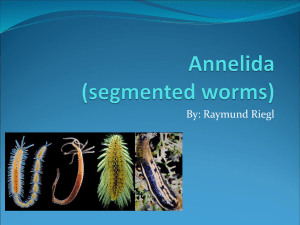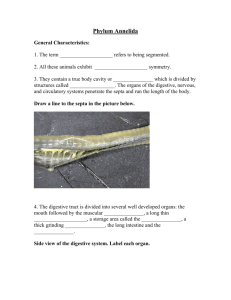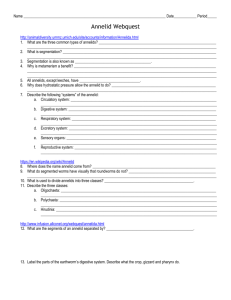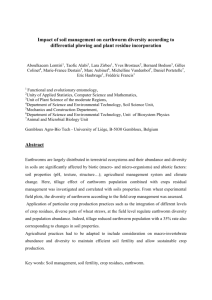Phylum Annelida
advertisement
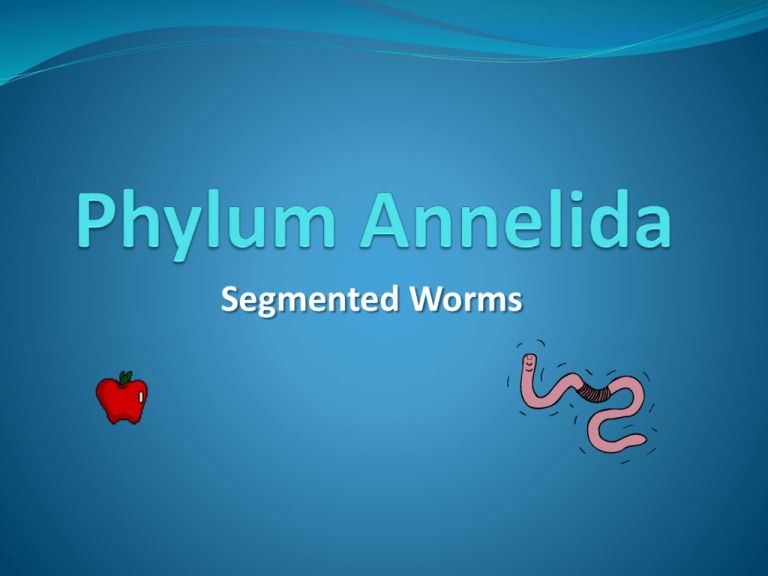
Segmented Worms Diversity Live in all parts of the world (except Arctic and antarctic regions) Can be marine, freshwater, or terrestrial Approximately 9,000 species Range in size from 1mm- 11 Feet Common Earthworm is 9-10 inches Known as segmented worms Ex: leech, earthworm Characteristics of All Annelids Body System: Tube within a tube Inner tube is the straight line digestive tract Extends from mouth (first segment) to anus (last segment) Outer tube consists of two layers of muscle, moist skin, a cuticle, and secretion of slimy mucous Fluid filled cavity between the two tubes Contains a well developed circulatory system Nervous system Thread like kidneys Reproductive organs Characteristics of All Annelids Bilateral Symmetry Metamerism (segmentation) Increases the efficiency of body movement Allows for greater complexity of the body systems Muscular Structure Both longitudinal and circular muscles Surrounded by moist cuticle (outer covering) which aids in breathing Characteristics of All Annelids Setae Used for locomotion Leeches do not have these Coelom is well developed Circulatory system is closed Digestive System is complete Respiratory System Gas exchange occurs through skin, gills, or parapodia Characteristics of All Annelids Excretory system A pair of nephridia Nervous System Double ventral nerve cord and pair of ganglia Sensory System Taste buds, photoreceptor cells and eyed with lenses (in most) Reproductive System Hermaphroditic or separate sexes May have asexual reproduction Classification Kingdom Animalia Phylum Annelida Class Oligochaeta Examples: Earthworms Class Polychaeta – means many bristles Examples: lugworms, clam worms, bristleworms Approximately 8,000 species Class Hirudinea Examples: leeches Often used in medicine to relieve swollen limbs, dry skin, etc. Worm composting Recycling the organic waste of a household into compost allows us to return badly needed organic matter to the soil Worm composting is a method for recycling food waste into a rich, dark, earth-smelling soil conditioner. Worm compost is made in a container filled with moistened bedding and redworms Add your food waste for a period of time, and the worms and micro-organisms will eventually convert the entire contents into rich compost. Composting DIY Class Oligochaeta Earthworms: •Burrow in soil •Come out at night to explore •Can drown if soil gets too wet •Diet: scavengers (eat dead, decaying matter) •Have the ability to learn! Class Polychaeta Polychaetes: •Ex: Christmas tree worm, Fireworm, Scaleworm •Largest group of annelids •Mostly marine •Brightly colored or can be dull in color Class Hirudinea Leeches: •Live mostly in freshwater •More abundant in tropical areas •Most are carnivorous (feed on meat, blood) •Have two brains! Characteristics of Earthworm (most “famous” of Annelids) Soil is natural habitat Burrows head first into soil (makes its burrow by using the pointed head end to push soil aside) Eats soil for food (obtains nutrients/water from the soil) Can feed on grass, leaf/scraps of organic matter Also digest humus (dead, decaying matter) Head end is light-sensitive Nocturnal—feed/eat/active during nighttime Characteristics of Earthworm (most “famous” of Annelids) Long, slender body (cylindrical) 150-200 ring-like segments Locomotion/movement—performed by layers of muscle in the body wall (circular bands of muscle) Ventral (belly) side has setae (bristle-like hairs) used for movement Mature worms have a clitellum (produces the egg capsule at breeding time)—larger segment (lighter in color) Respiration—through its moist skin (cannot become dry—worm would suffocate) Characteristics of Earthworm (most “famous” of Annelids) Organs: Pharynx—sucks in food (think of a vacuum) Esophagus—food enters here once enters mouth Crop—temporary storage (from esophagus) Gizzard—grinds food into small pieces Intestines—digestion and absorption occur here Aortic arches—-part of closed circulatory system, contains 5 of these, maintains a steady pressure of blood to vessels Ganglia—nervous system organ, brain Characteristics of Earthworm (most “famous” of Annelids) Nerve cord—runs from ganglia to each segment, provides nerves to body structures Blood vessel—part of closed circulatory system, moves oxygen throughout body Clitellum—reproductive organ, secretes mucus, stores eggs/sperm during reproduction Setae—movement and reproductive purposes Segments—mouth-anus sensory/excretory organs are attached to muscle wall of each segment Anus--excretion Nephridium—excretory organ, excrete ammonia Earthworm Dissection YouTube Earthworm Dissection Characteristics of Earthworm (most “famous” of Annelids) Other/Biosphere/Uses Help to aerate the soil Prepare soil with nutrients from excretory waste products Leeches can be used for medicinal purposes (for blood clotting issues) Earthworms: eat, fishing, aerate soil, etc Earthworm Pictures! Earthworm Pictures!


![earthworm [annelid – segmented worm]](http://s3.studylib.net/store/data/008502476_1-3ebb28d32ff3e90b09ed01ec69126429-300x300.png)

